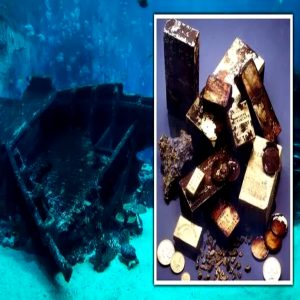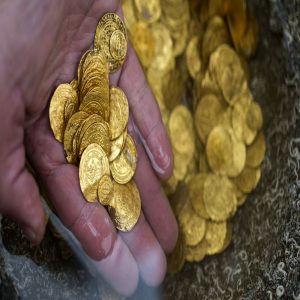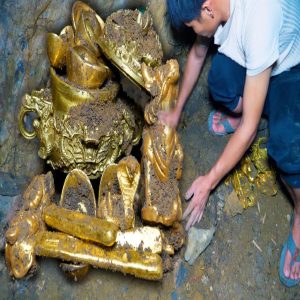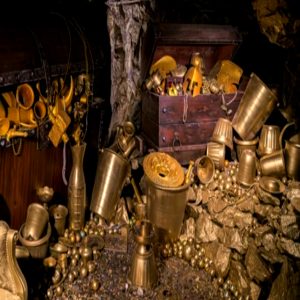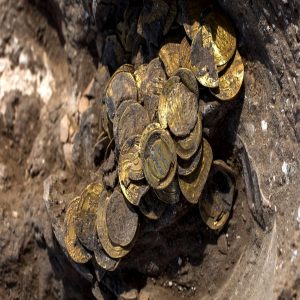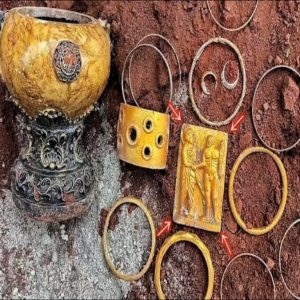In the Hebrew Bible, the third king of Israel, Solomon, is depicted as a wise, powerful, and immensely wealthy king, who ruled between 965 BC and 925 BC. It is written that he reigned over a prosperous empire and commissioned magnificent palaces and fortresses in Jerusalem, also building the first temple to store the legendary Ark of the Covenant, a gilded case believed to hold the original Ten Commandments as handed down to Moses by God. But when his Temple was destroyed by the Babylonians in 597 and 586 BC, it is said that the Ark and his other treasures disappeared, never to be seen of again.

In historical records, Solomon is portrayed as a king with an extreme amount of wealth. For example, in the Book of Kings I (one of the two biblical books from which most of our knowledge of Solomon is derived, the other being Chronicles II), it is written that,
Now the weight of gold that came to Solomon in one year was six hundred threescore and six talents of gold, / Beside that he had of the merchantmen, and of the traffick of the spice merchants, and of all the kings of Arabia, and of the governors of the country.
Additionally, it has also been recorded that,
King Solomon made two hundred targets of beaten gold: six hundred shekels of gold went to one target. / And he made three hundred shields of beaten gold; three pound of gold went to one shield: and the king put them in the house of the forest of Lebanon. / Moreover the king made a great throne of ivory, and overlaid it with the best gold.… / And all king Solomon’s drinking vessels were of gold, and all the vessels of the house of the forest of Lebanon were of pure gold; none were of silver: it was nothing accounted of in the days of Solomon…. / So King Solomon exceeded all the kings of the earth for riches and for wisdom.
The great wealth of Solomon has led many to believe that there is a great treasure hidden somewhere, awaiting its discovery. Yet, the exact contents of this ‘treasure’ are rather uncertain, and may range from gold and silver objects to the long coveted Ark of the Covenant.

The rich and powerful King Solomon with the Queen of Sheba, oil on canvas painting by Edward Poynter, 1890 (public domain)
The Treatise of the Vessels
In a Hebrew text called the ‘Treatise of the Vessels’, which was translated into English around two years ago, Solomon’s ‘treasure’ includes the coveted Ark of the Covenant, the Tabernacle, gold musical instruments, and the vestment of the high priest.
Other possible objects from the ‘Treasure of Solomon’ can be found in the numerous legends surrounding this king. One such legend speaks of Solomon being in possession of a seal ring on which the name of God was engraved. With this magical ring, Solomon was able to command demons to do his bidding.

King Solomon’s Ring – Designed be the Artist David Weitzman
Solomon’s Golden Table
Another artifact belonging to Solomon is his table, which appears in a story surrounding the Islamic conquest of Iberia. In this story, the governor of Morocco, Musa Ibn Nasyr, was in command of the invading force, and ordered Tariq Ibn Ziyad, one of his Berber vassals, to lead the vanguard. Tariq’s landing place, incidentally, is what is now known as Gibraltar (this name is said to be the Spanish derivative of Jabal Tariq, meaning ‘Mountain of Tariq’.) Before his overlord had even crossed the Strait of Gibraltar, Tariq had already defeated Roderick, the king of the Visigoths, and captured his capital, Toledo. It was in this city that Tariq is said to have found a golden table rumoured to have been from the Temple of Solomon, and claimed it as his war booty.
When Ibn Nasyr arrived in Toledo, he heard of the golden table, and desired it himself, so that he could present it as a gift to the Caliph in Damascus. As a result, the table was seized from Tariq. The vassal, obviously angered by Ibn Nasyr’s action, broke one of the table’s legs, and replaced it with an inferior one. Tariq knew that he overlord was uncultured, and would not know the difference, whilst the Caliph would notice it in an instant. This came true when Ibn Nasyr presented the table to the Caliph. When he was asked to explain, Ibn Nasyr could only reply that he found it that way. Tariq, who was also present at Damascus, then took the actual leg, as proof that the table was seized from him. Tariq was rewarded, Ibn Nasyr was punished, and the table, which was kept by the Caliph, eventually disappeared from history.
One last story pertaining a possible object in the ‘Treasure of Solomon’ can be found in a colourful tale called the ‘Legend of Prince Ahmed Al Kamel, or the Pilgrim of Love’, which can be found in Washington Irving’s Tales of Alhambra, a collection of stories picked up whilst he was staying in the grand Moorish palace in Granada. Solomon is referred to a few times in this story. For instance, the prince is said to have learned the language of the birds, rumoured to have been taught to Solomon by the Queen of Sheba. Solomon is mentioned again, as the owner of a silken carpet kept in a sandalwood box in the treasury of Toledo. This carpet (said to have been brought to Toledo by the Jews who took refuge there after the fall of Jerusalem) had magical properties, and was used by the prince to fly back to Granada with his Christian princess.

‘Pilgrim of Love’ stained glass window at Sunnyside Memorial Gardens, Long Beach, California (thinduck42 / flickr)
The Disappearance of Solomon’s Treasures
In 589 BC, the Babylonians under Nebuchadnezzar II laid siege to Jerusalem, culminating in the destruction of the city and Solomon’s Temple in the summer of 587 BC. It is said that at this point in time, Solomon’s treasures disappeared, never to be seen of again.
According to the Treatise of the Vessels, the treasures were hidden by a number of Levites and prophets and “hidden in various locations in the Land of Israel and in Babylonia, while others were delivered into the hands of the angels Shamshiel, Michael, Gabriel and perhaps Sariel”.
Archaeologists and historians are not sure whether the Ark of the Covenant was stolen, destroyed, or hidden, and many continue to search for this long lost treasure.
